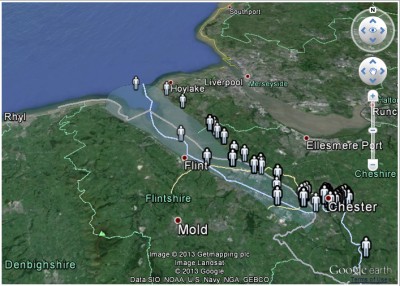 I’ve recently been revisiting the River Dee project with a view to creating an embedded Google Earth map of the geo-referenced data previously assembled (see ‘Sands of Dee’ webpage on liminoids.com). This is now finished and the map added to the website: http://www.liminoids.com/inthefield/sandsofdee/map.html.
I’ve recently been revisiting the River Dee project with a view to creating an embedded Google Earth map of the geo-referenced data previously assembled (see ‘Sands of Dee’ webpage on liminoids.com). This is now finished and the map added to the website: http://www.liminoids.com/inthefield/sandsofdee/map.html.
The Cestrian Book of the Dead is a necrogeographic map of the Dee Estuary, located between Flintshire and the Wirral Peninsula. ‘Cestrian’ is a term that refers to the city of Chester, which, until the 18th Century and the eventual silting of the River Dee, was a major port city.
The map features historical sites of drowning, developed by geo-referencing data from Chester City Coroner records, dating back to the early 1500s. Many of the deaths record specific or approximate locations, as well as activities the deceased were engaged in at the time of their death.
The map reveals an estuarine and riverine landscape that was a thriving social and cultural space, playing host to everyday practices such as washing clothes, bathing, leisure (William Cowpack met his end picking daisies), and travel. As a liminal landscape, the river and the ‘Sands of Dee’ – immortalised in Charles Kingley’s poem of the same name – was a space of transit, a borderzone, and the site of a major communication route between England and Wales.
On account of its hazardous and unpredictable terrain (as well as its attraction as a popular site of suicide), the river and estuary were also places where many of its wayfarers found themselves ushered over the threshold between life and death. The Cestrian Book of the Dead is a monument to the innumerable ghosts that still inhabit these spaces in-between.

